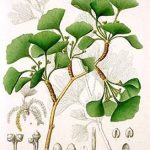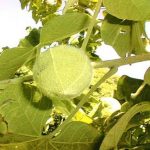TREE LIFE
June 2015
MASHONALAND CALENDAR
Saturday June 6th: Botanic Gardens Walk (NOTE CHANGE OF TIME): This will be the last walk with Tom before he sets off on his annual pilgrimage to Switzerland and the UK. A wonderful time of year to be walking in Tom’s garden and to absorb some of his knowledge and enjoy his humour and learn the history of the gardens – come and enjoy. Meet at 9.15 am in the car park of the Harare Botanic Gardens. This walk will last for 1 hr 30 mins.
Sunday 21st June : A return visit to Chedgelow Farm by kind invitation of Craig Dankwertz. It is aloe time and the veld should be ablaze with colour. A wonderful opportunity to spend a day in this magical piece of woodland which borders onto Henry Hallam Dam. We will meet at Mukuvisi Car Park 8.30am for a prompt get away. Bring your picnic lunch, chair and hat. There will be someone to look after the cars while we are walking so please also bring a “bonsella” for our car guard.
Saturday 27th June: A return visit to the National Botanic Gardens. We are going to walk at the top end of the Botanic Gardens and we have permission to drive to the base of the hillside to explore this previously unexplored (for many of us) piece of the woodland. We do have clearance from National Parks to walk in this area. Meet in the car park at 14.15.
NEW TREE SOCIETY CHAIRPERSON
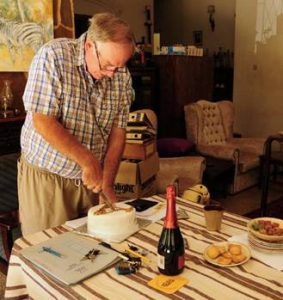
Mark Hyde cutting the cake to mark his last Committee Meeting as Chairperson
The committee says a sad goodbye to Mark Hyde, our excellent leader for so many years, and welcomes Tony Alegria to the position of chairperson. We look forward to a productive and growing Tree Society with Tony at the helm. Dave Hartung takes up the Vice Chairperson position, as per our constitution. – Ed
TREE OF THE MONTH Ziziphus mucronata
Family: – Rhamnaceae. Common names: Buffalo thorn; UmPhafa (Nd), Chinanga (Sh).
Etymology: In ancient Greece the tree was called zizyphon, from the Arabic zizouf, a name for the mythical lotus. In Latin it became zizyphum. The specific name mucronata means ‘pointed’, possibly referring to the thorns or the apex of the leaves.
In Zimbabwe the family Rhamnaceae is represented by two species of Berchemia – B. discolor and B. zeyheri, Rhamnus prinoides and three Ziziphus: Z. mucronata and Z. abyssinica. The third species is Z. mauritiana, the jujube tree, which was imported from India and has naturalised in some parts of Zimbabwe.
The buffalo thorn is distributed throughout the summer rainfall areas of sub-Saharan Africa, extending from South Africa northwards to Ethiopia and Arabia.
Ziziphus mucronata grows in areas dominated by thorny vegetation in both temperate and tropical climates. It is also found in a wide range of habitats such as woodlands, open scrubland, on rocky kopjes, open grasslands, and on a variety of soils along streams, nutrient-rich valley bottoms and forest margins. It reaches its largest size on the margins of scrub forest and on deep, alluvial soils near water. Its presence is said to indicate the presence of underground water.
The bark is grey to dark grey and fissured into small rectangular pieces. The branches are generally drooping, the young stems reddish brown and often zigzagging between the pairs of spines. It’s paired stipules are spinescent, one hooked sharply downwards, the other curved slightly upwards and they can be absent on mature trees.
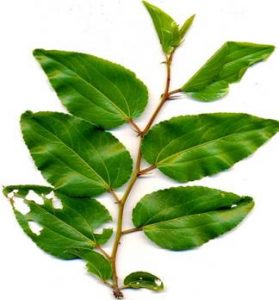
Ziziphus mucronata leaves
The leaves are ovate to broadly ovate, 3 to 8 cm long by 2 to 5 cm wide. They are 3-veined from the base, shiny green, only slightly paler green below, and mostly hairless but sometimes with short, soft, pale brown, woolly hairs on the under surface. The apex is broadly tapering, often with a sharp tip while the base is rounded to lobed and markedly asymmetric. The margin is finely toothed around the upper two-thirds and often wavy. The petiole can be up to 7mm long, with short, soft hairs. The flowers are small, yellowish, inconspicuous, in tight axillary clusters, often producing copious nectar (Nov.-Feb).
The fruit is almost spherical, about 1.5 cm in diameter, shiny russet-red; with a thin layer of rather dry, meal-like pulp, often remaining on the tree over winter until the leaves fall (Mar.-Aug.). The leaves and fallen fruit are browsed by stock and game, and can provide useful fodder in times of drought.
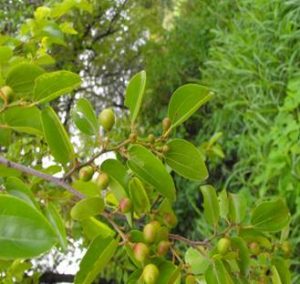
Ziziphus mucronata fruit
Historically, the genus is of interest, Christ’s crown of thorns is supposed to have been made from Ziziphus spina-christi (L.) Desf., a species which closely resembles Z. mucronata but which grows from central Africa northwards.
Ziziphus mucronata has numerous magico-medicinal uses and the seeds have been used in the past as rosary beads. A widespread remedy for almost any pain is a poultice made of the powdered and baked roots; once removed from the affected area, the poultice is eaten. Boils and other skin infections can be treated with paste made from the leaves and this, together with a dose of root decoction, is the accepted treatment for tubercular gland-swellings among some rural people. Sufferers from dysentery and lumbago either chew the root or drink an infusion made from it. The powdered leaf and bark has been used to relieve chest complaints and an infusion of the bark alone cures coughs. In Botswana this tree is considered immune to lightning, so any person sheltering under it is thought to be safe. It is also believed that if a tree is felled after the first rains, a drought will certainly ensue.
An interesting AmaNdebele custom is to spread leaves of Ziziphus on the grave after burial. Africans have many beliefs attached to this tree. Zulus and Swazis also use the Buffalo Thorn in a connection with burial rites. It was once customary that when a Zulu chief died, the tree was planted on his grave as a reminder or symbol of where the chief lies. Hence the name umLahlankosi – that which buries the chief. A twig from the tree was and is still used to attract and carry the spirit of the deceased from the place of death to the new resting place. When a stock owner died, and was buried according to custom within the cattle or goat kraal, some branches were placed on the grave so that the animals nibbled on leaves and twigs, and so understood that their master had died. In other parts, people drag a branch round the village to protect it from evil spirits.
The berries were used by residents in the former Transvaal in making porridge or as a coffee substitute. The fruit can also make a beer if fermented properly. During the Anglo-Boer war, the seeds were ground and used as a coffee substitute.
Sources:
Coates Palgrave, K. 1977. Trees of Southern Africa . Struik, Cape Town.
Gelfand, M. et.al. 1985. The Traditional Medical Practitioner in ZImbabwe. Mambo Press, Gweru.
Goldsmith, B. and Carter, D.T. 1992. The Indigenous Timbers of Zimbabwe. Forestry Commission, Harare.
Palmer, E. and Pitman, N. 1972. Trees of Southern Africa. A.A. Balkema, Cape Town.
PlantzAfrica – Website of the South African Botanical Institute. www.plantzafrica.com
Nyathi, P. 2001. Traditional ceremonies of the AmaNdebele. Mambo Press, Gweru.
Van Wyk, B. and Van Wyk, P. 1997. Field Guide to the Trees of Southern Africa . Struik, Cape Town.
Photographs: JP Felu.
– JP Felu
TREE SOCIETY VISIT TO CATAPU, SOFALA PROVINCE, MOZAMBIQUE 25th APRIL – 2ND MAY 2015
This is a report on the second visit of the Tree Society to Catapu, Ant White’s logging concession in central Mozambique. Our first visit was just over three years ago in early April 2012.
Friday, April 24th and Saturday April 25th
The days leading up to the trip were spent trying to work out what paperwork was needed and then acquiring it – a Mozambique visa, Zimbabwe police clearance for the car and some meticais (which oddly do not seem to be sold by Zimbabwean banks!).
Anticipating the state of the roads in Mozambique, we had allowed two days to do the c.700 km journey. So, on Friday, Tom Muller, Meg Coates Palgrave and I travelled along Zimbabwe’s excellent roads to Mutare, coincidentally meeting two Committee members on their way to a bird outing at Outward Bound. The border crossing was straightforward and we journeyed on to Casa Msika just off the road between Manica and Chomoio.
There we did some late afternoon tree-ing and managed to find an interesting little species of Desmodium (triflorum) in the open areas between the chalets. Casa Msika was comfortable and also offered us free Wi-Fi, a small bonus, so I was able to Skype Linda in the evening. Mary, Graham and Bilal arrived later and we had a convivial supper at the restaurant.
The next day of driving, Saturday, was less pleasant and we made rather slow progress along the dreadfully potholed EN1, finally reaching Catapu in the mid-afternoon. While we were settling in, Bilal arrived to tell us that Mary had hit a pothole and done some major damage to her car, fortunately quite close to the Catapu turnoff. Ant White and Joe the mechanic came to the rescue and the car was brought in to the sawmill for inspection on Monday.
– Mark Hyde
Day One – Sunday 26th April
The much prepared for, and looked forward to, return visit to Catapu arrived and after an easy and comfortable drive to Chikamba Dam/ Casa Msika we arrived to find Meg, Mark and Tom already botanising – this was going to be an exciting time with the “Botanical Trinity” agreeing/ debating/arguing – but always gently.
M’phingwe is a delightful set up and provides an hospitable, clean and secure stop over or stay over with comfortable chalets, good food and ice cold beer. All thanks to Ant for providing it and to Meg for organising it. At this stage we were only 6, the other contingent of 7 were only to arrive on Monday evening.
M’phingwe = Dalbergia melanoxylon = African blackwood or Zebra wood – Tree sp. 104 on the Catapu and environs list of trees. This is a very prominent species in the concession and Ant’s theory is that his program of early burning is a contributory factor as the young seedlings survive the early burn and have become “fire resistant” over the years.
Catapu – a timber concession of 30 000 ha situated 32 km South of Caia on the Zambezi in Sofala Province – has been managed by Ant since 2000 in a commendably sustainable way. The allocation of timber amounts to 2200m3 per annum and the concession has been divided into 30 blocks worked in rotation, so the ‘take off’ amounts to 2.2 m3 per/ ha /per annum which is equal to 1.5 trees per hectare per annum. These are felled in such a way so as to cause minimum impact on neighbouring trees and the drag lines are sown with seed and covered. The stump is marked with the date of harvest and the name of harvester. The resulting coppicing is carefully managed and by the end of the cropping rotation – 30 years hence – the tree is almost ready to be harvested again.
There is also a vigorous reforestation programme in progress of which Ant is very proud. He is also encouraging the local population to manage bees in Top Bar hives which give them a steady supply of honey, an increasingly sustainable income, but – most of all – is saving many trees from being hacked down for a couple of kilograms of honey. On top of all of this there is the huge sawmill operation going on.
At breakfast on Sunday morning Ant arrived carrying a yellow plastic bag containing a rather frustrated +/- 3m python he had just caught and which he was about to release at a far-away pan – would we like to come? With my vehicle off the road we climbed aboard Ants bakkie together with Mandy, Piglet (Ant’s Jack Russell) and a now lethargic python.
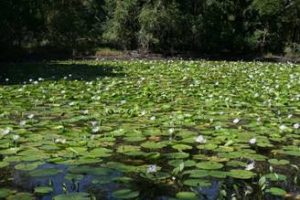
The pans have literally blossomed – how miraculous the resilience of nature
All the pans on the concession are “pom” full following an excellent rainy season of over 1100 mm (the usual average is between 600-700 mm p/a). The pans have literally blossomed – how miraculous the resilience of nature. Not only water plants – Joe has caught lung fish and catfish as one would expect but also bream and a small tiger (has photographic evidence) – the speculation being that it might have been carried, as eggs, on some bird.
To get back to botanising around Njiri (warthog) Pan, described as a temporary pond with sedges. There was excitement over the finding of Ottelia exserta plus another unknown multi-headed water plant, probably an Ottelia species and Limnophyton obtusifolium. Around the pond were observed Tamarindus indica and Meg reminded us that the theory was that this tree is, in fact, native to Africa and not to India as the name implies – it was named in India, hence the indica. Also Garcinia livingstonei, Cissus integrifolia – depavine – and saviour of thirst travellers. There was debate over Sphenoclea zeylanica.
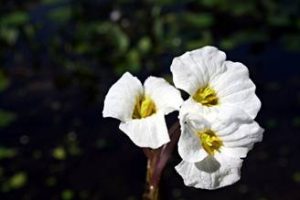
Unknown multi-headed water plant, probably an Ottelia.
We made a brief stop at the pan where Joe was fishing and then on to “python release” pan – a really beautiful stretch of water and a surely ideal home for our lady python who was not at all happy about being moved around from the back of the hot truck to the water’s edge. The bag was untied, Jack Russell quivering with excitement and Mark at the ready to video the action for Youtube! Once freed she slithered to the water’s edge and glided gracefully into the cool water – what joy. We spotted her a few minutes later about 20m away lying in shallow water – I feel sure greatly relieved to be free after her ordeal.
After all that action Tom and Meg went back to the car to press the water plants they had collected while we did a bit of not very serious botanising – it was very hot by this time. We found Piliostigma thonningii with male flowers, fibre from the bark is used as twine. Both the leaves and the fruit are eaten by stock and game. Macerated and boiled, the roots and bark yield a reddish dye; a blue/black dye is obtained from the pods and seeds. Pods are pounded to make a meal rich in ascorbic acid (Vitamin C). The butterfly Charaxes achaemenes achaemenes breeds on the plant. Hippocratea crenata, Lecaniodiscus fraxinifolius, Grewia microcarpa were noted and also a very fine leaved Ipomea coptica – such a delicate plant.

Ant “fishing” for water plants in Njiri (warthog) Pan, described as a temporary
pond with sedges.
By this time it was very hot and so back for lunch and a welcome zizz and then out with Ant to Zalula Pan where we sundowned to the chorus of myriad reed frogs and the peace of a waxing moon. Mark botanised around the pan, but most of what he collected was put in the bag to take back for identification.
Not the most productive botanising day, but a day filled with interesting tit bits – driving through the forests we saw nyala, red duiker and many suni. The grasses, all seeding now, are a wonderful sight and then the butterflies – masses and masses of them of every hue and size. The country is looking wonderful after the good rains.
That was not the end of the excitement for the day. Bilal, Graham and I were quietly having a nightcap and chocolate back in our cabin and mulling over the day’s events when Bilal observed a long green snake slither out from under Graham’s bed ! Much debate followed as to whether we should disturb Mandy or Ant. We did. Mandy came across and decreed that it was a Boomslang and she would need Ant to catch it. After some considerable time of pushing furniture around Ant appeared with a “what a beautiful girl she is” Boomslang wrapped up in Graham’s towel and took her out into the pale moon light to release her in the nearby bush !!
As I write this on my return to Harare, how do I sum up a week of exciting botanising with Meg and Mark and Tom? The biggest bonus, as far as I was concerned, was all the botanical debate and the camaraderie with like-minded people in beautiful forests.
– Mary Lovemore
TO BE CONTINUED……..
TONY ALEGRIA CHAIRMAN


